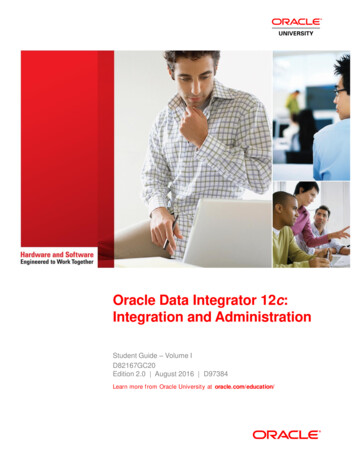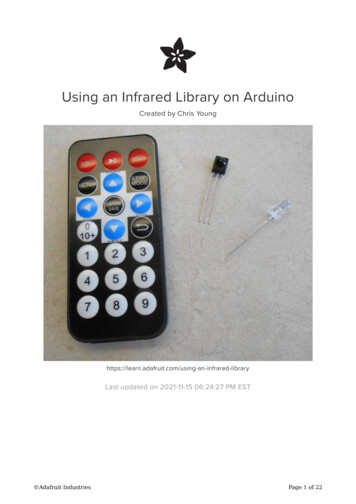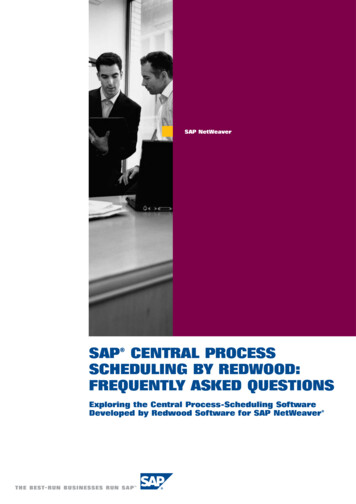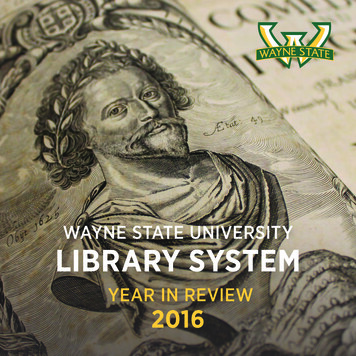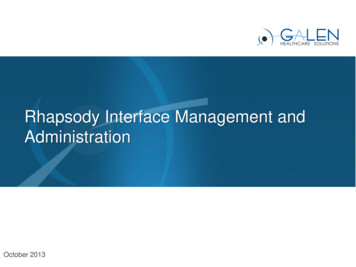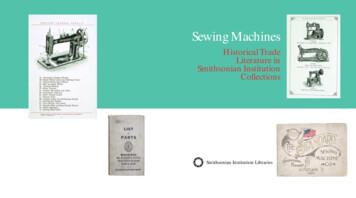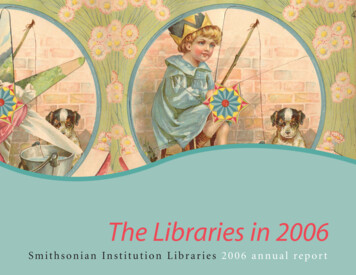
Transcription
The Libraries in 2006Smithsonian Institution Libraries 2006 annual report
Smithsonian Institution Libraries 2006 Annual Report“Knowledge, Friendship, Understanding, and Wisdom” – these are the wordscarved on the façade of the library at Ephesus in Turkey. The Temple of Artemis was amagnificent library, holding 12,000 scrolls, as well as a large theater with 12,000 seats. Arenot these inscribed virtues what we strive for today? Libraries are where the knowledge ofthe ages is kept. It is in that spirit that we present the Smithsonian Libraries’ Annual Reportfor Fiscal Year 2006. You will find here that we are still acquiring books, photographs, documents and other resources, in print and in digital form, but we are also sharing our richeswith a world-wide audience. Over three million visitors last year to our Galaxy of Imageswebsite seem to think we have something worth pursuing. Our Smithsonian researchersbenefit from daily interaction with our expert staff. I am grateful for their commitment andhard work, as I am for the many supporters who are listed in our pages of donors.Thank you, each and every one, for making 2006 a great year!Nancy E. GwinnDirectorFrom Unterhaltungen aus der Naturgeschichte: des Mineralreichs. [see p. 23]Website Statistics Website usage for 2006 reached an all time highof over 3.4 million user sessions and 103 million hits. Overall, 2006 showeda 31% increase in user sessions over 2005 and visitorship has nearlyquadrupled since 2002. March 2006 set a record for user sessions withover 457,000 visitors to the website. Traffic was driven by the increasedusage of the online Biologia Centrali-Americana site, the addition of theSmithsonian Contributions site and the array of SIL Online Exhibitions andSIL On Display projects, including Drawing From Life and From Horses toHorsepower: Studebaker Helped Move a 4071,814,0592,376,7153,425,485MonthlyAverage essions74,722
Biodiversity Heritage Library Working with an international consortium of 10major natural history museum, botanical garden and university libraries and researchinstitutions, SIL is at the center of an initiative to create a Biodiversity Heritage Library(BHL) by digitizing the published literature of biodiversity held in their respective collections.Biodiversity describes the variability of living organisms on the earth. From the 17thcentury and earlier, investigators have published their descriptions of species and theirecosystems in books and journals, often with beautifully colored illustrations. This isthe literature that will be digitized and made available through a global “biodiversitycommons,” freely available to all. SIL launched the BHL website, www.bhl.si.edu, inDecember 2005, and in May 2006 opened a portal to approximately 100,000 pages ofonline taxonomic literature from Smithsonian collections: www.sil.si.edu/digitalcollections/BHLCollections. The Richard Lounsbery Foundation awarded 50,000 to SIL tocreate a BHL Metadata Repository, containing records of the biodiversity literature fromparticipating members, and to carry out collections analysis to help establish priorities.The BHL has been embraced as the foundation of a great- From Samuel P. Langley: Aviation Pioneer (Part 1)er initiative called the Encyclopedia of Life, a collaborativeglobal project with the goal of cataloging the complete setof proteins of every living species in a flexiblereference system.From MuseumCarlsonianum[see p. 23]Additions to Galaxy of Knowledge Samuel P. Langley: Aviation Pioneer (Part 1) by William E. Baxter. Very few people today realize that the Smithsonian’s third secretary Samuel P. Langley almost succeeded with inventingthe airplane before the Wright brothers. Who was Langley and what did he do? http://www.sil.si.edu/ondisplay/langley/ Mail Call! A Postal History Booklist for Young Readers by Paul K. McCutcheon. A bibliography for young readers on postal history. ry/Mail-Call/ Index Animalium by Charles Davies Sherborn. A compendium of zoological taxonomic species nomenclature from 1758 to 1850. For each species described in this period itclearly lists the genus name, author, publication, pages, and date. A crucial tool for taxonomists, Index Animalium contains references to over 400,000 names compiled from earlytaxonomic literature. alium/ Smithsonian Contributions to Botany and Earth Sciences. Two series that publish reports on the scientific research conducted by Smithsonian staff and their professionalcolleagues, as well as the collections of the various Smithsonian museums in the fields of botany and earth sciences. /EarthSciences/ continued on next page3
Smithsonian Institution Libraries 2006 Annual ReportSmithsonian Digital Repository Last year saw much progress on the establishment of a Smithsonian Digital Repository, which willallow researchers to quickly find the digital research products of the Institution. SIL obtained a server to mount a pilot project with contributions of digitized published articles from staff of four Smithsonian science units. Initially, the repository will handle articles, preprints, working papers, technical reports, conference papers,From Unterhaltungen aus der Naturgeschichte: des Mineralreichs. [see p. 23]other Smithsonian publications and associated data sets. TheSmithsonian Archives is also using the repository for digitalrecords management. The repositorywill provide a permanent address forthe materials, assuring their long-termaccessibility and preservation in a secure, professionally managed environment. At year’s end, SIL had acquireda second server, which will allow forpublic access to the repository.From A Jules Verne Centennial: 1905-2005 A Jules Verne Centennial: 1905-2005 by Norman Wolcott. The Libraries is fortunate to have a few early editions of Verne’s workswith the original engraved illustrations that made his works so popular. Later reprints usually omitted these engravings, and since theoriginal woodcuts and early printing plates are long gone, all that remains are these images from the early books http://www.sil.si.edu/OnDisplay/JulesVerne100/ Instruments for Science, 1800-1914: Scientific Trade Catalogs in Smithsonian Collections. Additions to this important collection brings thetotal number of catalogs to 207 and the total number of images to over 17,000. erature/ Biodiversity Heritage Library Project. Provides access to over 77,000 page images related to biodiversity. In addition to the previously availableScientific-instruments/continued on next page4From A Jules Verne Centennial: 1905-2005
Art & Artists Files in the Libraries Collections The Smithsonian artists’ files are anexceptionally valuable resource for historians researching emerging regional and localartists and often are the only accessible sources of information. The Web site presentsthe holdings of the five Smithsonian art libraries and will grow to include artists in the collections of non-art libraries at the Smithsonian. In FY 2006, 76,400 records for names ofartists were added to this ongoing rt-design/artandartistfiles/Web of Science, More Online Journals In December, the Libraries announced theavailability of the extraordinary database Web of Science to Smithsonian scientists andresearchers. Web of Science provides Smithsonian scientists with broad access to published scientific journal literature and allows for a single search interface to cover multiplejournals.The Libraries now can provide access to the full text of back files of hundreds of journals in the arts and sciences through JSTOR. These tools save researchers manyhours in finding and obtaining copies of journal articles and other information they needto keep current in their fields.From Joseph Albers. Interaction of Color, 1963Biologia Centrali-Americana, United States Exploring Expedition, Smithsonian Contributions to Botany and others, new content is now available through a scalable page-turner developed inparallel with the Missouri Botanical Garden. tions/ Your Smithsonian Libraries. Did you know the Smithsonian has a library? Actually, the Smithsonian has 20 libraries, showcased by this exhibition, combined into onesystem and supported by an online catalog of the combined collections of over 1.5 million books, 50,000 rare books, 10,000 historic manuscripts and over 2,000electronic journal titles. ibraries/ Textile Fiber Atlas: A Collection of Photomicrographs of Common Textile Fibers (1942) by Werner Von Bergen and Walter Krauss. An indispensable aid inproperly identifying textile objects and remains a classic reference in textiles research. This volume has provided generations of textile students with definitive images offibers at high magnification, along with careful directions and precise notes. tions/ On the Crinoid Genus Scyphocrinus and its Bulbous Root Camarocrinus (1917) by Frank Springer. This paper, originally intended merely as an account of aremarkable discovery in 1912, has, by force of repeated further acquisitions of material, expanded into a memoir requiring nine plates and numerous ons/BHLCollections/BHL title.cfm?bib id SIL-036-008 continued on next page5
Smithsonian Institution Libraries 2006 Annual ReportSmithsonian Scholarly Press—ANew Partner Over the past year, theLibraries has developed a vital partnershipwith the revitalized Smithsonian ScholarlyPress. This new office will manage the production of the various Smithsonian Contributions series of publications authoredby Smithsonian research staff. SIL agreedto digitize all of the past Contributionsvolumes and to design and host the Press’swebsite, http://www.scholarlypress.si.edu/.Already available online and in full textat http://www.sil.si.edu/smithsoniancontributions/ are Contributions to Botany, EarthSciences, History and Technology, Paleobiology, Marine Sciences, Air & Space, andthe Annals of Flight - with more to come. All images from Cinderella, or, The little glass slipper [see p. 23]Smithsonian History and Culture Collections Report of Hon. William H. Witte, from the Committee of the House of Representatives, to which was referred the letter ofthe Hon. Rufus Choate, on the Smithsonian Institution (1855). tions/HST title.cfm?bib id SIL-007-509. Smithsonian Institution . / by Charles Minor Blackford, Jr. M.D., reprint from the North American Review for January,1909, with revisions by the ions/HSTCollections/HST title.cfm?bib id SIL-007-508. An account of the Smithsonian Institution : its founder, building, operations, etc. / / prepared from the reports of Prof.continued on next page6
Staff on the MovePromoted Eric French,Museum Studies &Reference LibraryThomas Garnett,Associate Director,Digital Library &Information SystemsKathy Hill,AdministrativeOfficerGeoffrey Rinard,CatalogingAnne Westbrook,CatalogingKirsten Van Der Veen,Special CollectionsJoined Catherine Fraser,Director ofDevelopmentKannan Mahadevan,Student ProgramScott Scholz,Student ProgramRetired Tom Baker,CatalogingHelen Holley,NMAH LibraryDeparted Kent Boese,CatalogingRon Brashear,Special CollectionsSusan Cimburek,NMAH LibraryNedra Lee,Director’s OfficeRobert Kearns,Director’s OfficeGwen Leighty,Development Office Kannan Mahadevan(Student Program)Barbara Insidioso,CatalogingAll images from The New York Coach-Maker MagazineHenry to the regents, and other authentic sources (1866?) by William Jones Rhees. tions/HST title.cfm?bib id SIL-007-510. Unveiling the statue of Joseph Henry : Smithsonian grounds, Thursday, April 19, 1883 TCollections/HST title.cfm?bib id SIL7-154. The Smithsonian Institution, a revelation TCollections/HST title.cfm?bib id SIL-007-511. The watch factories of America, past and present. A complete history of watchmaking in America, from 1809 to 1888inclusive (1888) by Henry G. Abbott. tions/HST title.cfm?bib id SIL-029-015. The New York Coach-Maker Magazine. Begun in June, 1858, the New York Coach-Makers’ Magazine was “Devoted to the Literary,Social and Mechanical Interests of the Craft” and directed primarily to proprietors of the coach de-literature/NYCoachMakersMagazine/7
Smithsonian Institution Libraries 2006 Annual ReportSpencer Baird Society 7th Annual DinnerOn May 11, 2006, in the spectacular PotomacAtrium of the National Museum of the AmericanIndian (NMAI), guests were entertained by Kateand Jim Lehrer with stories of their creative lives.Kate writes award-winning novels about strongwomen who go against the norm, as well as shortstories, essays and book reviews. Jim, anchor,executive editor and host of PBS’ The News Hourwith Jim Lehrer, writes fiction and nonfiction.The Spencer Baird Society is the donor-recognition organization of the Smithsonian InstitutionLibraries.Left to right: Neil Turtell of the NationalGallery of Art, Tom Klaren, and Librariesdirector Nancy E. Gwinn enjoy the receptionfor the Libraries’ Spencer Baird Society.From Cinderella, or, The little glass slipper [see p. 23]New Endowment for National Museum of American Indian Library The National Museum of the American Indianco-hosted the Spencer Baird Society Benefactor’s Dinner. Event proceeds established a 50,000 endowment for support ofthe NMAI Library. In his remarks that evening, Tim Johnson, NMAI Associate Director, praised the Libraries for its support inbuilding and caring for the library’s collections. He spoke of how dependent staff and visitors are on library information aboutthe heritage and culture of Indian tribes in the western hemisphere.8outreach
From Museum Carlsonianum [see p. 23]Kate and Jim Lehrer, novelists, writers, and TV and radio personalities, entertainedthe audience with stories of their creative lives.Above: John Furth greets Senator Benjamin NighthorseCampbell and Patricia Schroeder, President & CEO of theAssociation of American Publishers.Right: Smithsonian Libraries Board Founding Chair RosemaryRipley enjoys a humorous story told by Aileen Train, as herhusband, The Honorable Russell E. Train, looks on.9
Smithsonian Institution Libraries 2006 Annual ReportVisitors, Tours SIL became an active contributor to the new EDGE (Education Data Gatheringand Evaluation) web-based reporting system used Smithsonian-wide to collect and report audiencedata for education programs. The Libraries began collecting this type of data independently severalyears ago to better define SIL’s education and outreach objectives. This data helped to establish abaseline for the Libraries’ programming efforts, both internally to the Smithsonian community andexternally to the general public, library professionals and non-Smithsonian scholars and researchers. Over 100 tours with 2,000 participants – including Elderhostel, Maryland Library Association,Panamanian Ambassador to Belgium, Alice Deal High School math class, School Without WallsParticipated in six open houses/festivals/public events with over 2,000 attendees25 staff presentations to 650 attendeesOver 65 training workshops with 875 participants – including “Desktop Doctor” sessions forresearchers, Sotheby’s Institute Art Program, orientations for gallery docents, Catholic Universitylibrary school studentsAbove: The Libraries hosted Chuck and JessicaMyers, right, with Amy Watson of the HirshhornMuseum and Sculpture Gallery Library, winnersof a rare book tour in the 2006 Arena StageAuction .Below: Michael Godow, Library Director andSpecial Collections Manager of The FieldMuseum, Chicago, visited the Book ConservationLaboratory and SIL Imaging Center.Dr. John Stachel2005 Dibner Library Lecture – “1905: Einstein’s Miraculous Year”The United Nations endorsed the year 2005 as the World Year of Physics, a time for international celebration of the pioneering contributions of Albert Einstein in 1905 and an opportunity to increase worldwide awareness of the major role physics will play in the coming millennium. On December 13, 2005, an audience of 100 welcomed Dr. John Stachel, Professorof Physics Emeritus and Director of the Center of Einstein Studies at Boston University, to the Carmichael Auditorium. Headdressed Einstein’s annus mirabilis, or “miraculous year.”10outreach
CIRLA Fellows For the past two years, the Libraries has hosted three participants from the CIRLA Fellows program: Jade Alburo, NettaCox and Amber Thiele. CIRLA, the Chesapeake Information and Research Library Alliance, is a not-for-profit organization of educationaland research institutions in Delaware, the District of Columbia, and Maryland, committed to education and research at member institutions through collaborative development of library collections and service programs and expanding use of information technology. The Fellows Program, funded by a grant from the Instituteof Museum and Library Services, was designed to: Contribute to the diversity of the profession particularly among academic librariesby recruiting individuals who are members of a traditionally underserved ethnicor racial group, or through their ability to demonstrate contributions to diversitybased on background or experiences Recruit the next generation of librarians to fill the numerous anticipatedvacancies in research libraries over the next ten years Train and educate new librarians in functional specialties needed by researchlibraries.The Fellows’ success was built on a structured and balanced program that provided mentoring, training and support. Jade, Netta and Amber received theirgraduate degrees, successfully completed the program and now have theopportunity to launch their careers through a full-time, one-yearpost-graduate appointment at the Library of Congress.From Circling Surprises [see p. 23]Resident Scholars The Libraries offers two Resident Scholar programs, The Dibner Library of the History of Science andTechnology Resident Scholar Program, and Baird Society Resident Scholar Program. The 2006 scholars and their topics were: Mr. Daniel G. Campos, Ph.D. candidate, Department of Philosophy of Pennsylvania State University. “The Development of Mathematical Probability Theory, 1713-1812.”Dr. Lesley Cormack, Professor and Chair of the Department of History and Classics of the University of Alberta, Canada. “The Molyneux Globes: Instruments, MathematicalPractitioners, and the Scientific Revolution.”Ms. Tayra Lanuza-Navarro, Ph.D. candidate, Institute of the History of Science and Documentation “López Piñero” of the Faculty of Medicine of the University of Valencia,Spain. “Astrology and Religion in 17th-Century Spain.”Dr. An Smets, Scientific Collaborator in the Unit of Medieval History in the Faculty of Philosophy and Letters at the Catholic University of Louvain, Belgium. “The LiberAggregationis: A Case Study of Translation of Medieval Scientific Treatises.”Dr. Ian G. Stewart, Senior Fellow in the Foundation Year Program and Adjunct Faculty in the History of Science and Technology Program of the University of King’s College inHalifax, Nova Scotia. “William Gilbert’s ‘New Philosophy Concerning Our Sublunary World’ (1651): A Critical Edition and n/index.htm11
Smithsonian Institution Libraries 2006 Annual ReportCoping with Mother Nature Heavy rains in June caused massiveflooding in the D.C. area; power failures forced the closure of the Natural History and American History Museums for several days. Amongthe libraries, the worst damage occurred at the Freer/Sackler Galleriesof Art Library, when water poured through the ceiling (the library isunderground in the Arthur M. Sackler Gallery building) and onto anarea of stacks. Freer-Sackler and Libraries staff responded quickly to drythe books and put the wettest pieces in plastic bags in a freezer to avoidmold. The 170 items affected were all journal volumes and issues. Although not rare, they would have been difficult to replace.At left and below: Staff at work on drying theaffected pieces from the collection.From Museum Carlsonianum [see p. 23]12collections
Reception to Honor Train Donation On December 4, 2005, friends of the Libraries, the Natural History Museum, and Russelland Aileen Train gathered for a peek at their recent donation to the Libraries of the extensive Russell E. Train Africana Collection.Secretary Lawrence M. Small opened the evening, appropriately held in the Museum’s Hall of Mammals, with a description of thecollection, which includes the rifle owned by David Livingstone at the time of his death.Several tables displayed books, manuscripts, photographs, art works, newspapers, andother materials related to African exploration from the 17th to 20th centuries.Above: The crowd examinesthe Train collection.Below: The HonorableRussell E. Train.13Mt.Kilaminjaro. Frederick Halpern. Aquatint etching, no date.
Smithsonian Institution Libraries 2006 Annual ReportThe Libraries in 66784,9639,6187,3635,82233,349103,877,548Branch LibrariesNumber of staffVolumes added to collectionTotal volumes heldJournal subscriptionsGift volumes added to the collectionCatalog records in SIRISTotal collection images on websiteElectronic journals and databases available to usersReference questions answeredNon-Smithsonian library researchersInterlibrary loans of books and articlesBooks and articles borrowed for SIImages added to Galaxy of Knowledge websiteHits on Galaxy of Knowledge websiteFrom Unterhaltungen aus der Naturgeschichte: des Mineralreichs. [see p. 23]From Cinderella, or, The little glass slipper [see p. 23]14collections
Your Smithsonian Libraries This exhibition opened in the Libraries galleryin the National Museum of American History on May 26 and ran through September 4. The exhibition consisted of colorful posters featuring images fromthe collections of each of the Smithsonian’s 20libraries, as well as two exhibition cases withintriguing volumes from the collections. Libraries’ designer Elizabeth Periale createdall of the graphics.An onlineversion of theexhibition canstill be viewed:http://www.sil.si.edu/Exhibitions/ yoursmithsonianlibraries/Gould Exchanged for Sparrman The Libraries successfully exchanged aduplicate copy of John Gould’s Birds of Great Britain (London, 1862-1873)for a much desired volume, A. Sparrman’s Museum Carlsonianum(Stockholm, 1786-1789). The Sparrman work is of major importanceto Smithsonian research for the ornithology of Southern Africa andthe South Pacific, as it illustrates many specimens collected by Sparrman duringCaptain Cook’s second voyage (1772-1775) and at his residence at the Cape. Itis the first work of its kind that exclusively applies Linnaeus’ method in its taxonomicnomenclature and is highly prized for its 100 hand-colored engraved plates. Onlythree copies of the work are listed in the United States.From MuseumCarlsonianum [see p. 23]15
Smithsonian Institution Libraries 2006 Annual ReportGiving Back at Work When F. Christian (Chris)Thompson first came to work at the Smithsonian, the factthat the institution had beenstarted with an endowmentfrom James Smithson was notlost on him. Chris’s mother,Elinor Bunn Thompson, hadworked as the assistant to theDean of the Harvard DivinitySchool in the 1950s. He remembers his mother telling a storyabout the Rockefeller family’sdecision to build a residencehall for the School. As sheF. Christian (Chris) Thompsontold it, after the Rockefeller representatives hadagreed on the donated amount and left the campus,Mrs. Thompson went to her dean and said, “Why notask for 2 or 3 million (dollars) continued on next pageFrom Cinderella, or, The little glass slipper [see p. 23]Left: Libraries Associate Director for Reader’sServices Mary Augusta Thomas and Cooper-HewittLibrarian Stephen van Dyk with the PicturingWords traveling exhibit at the Connoisseur’s Fair.Fundraising Event for Cooper-Hewitt National Design Museum’s Library The Libraries’ Picturing Words traveling exhibition accompanied twelve rare books from the Cooper-Hewitt library’s collection at the November 16, 2005 preview openingof the Art and Antique Dealers League of America’s Connoisseur’s Fair at the Gramercy Armory in New York City. The ticketed event raised nearly 25,000 for the library’s acquisition fund. The event attendees enjoyed items from the library’s collection of decorative arts materials, ranging from 16th-century architecture manuals to pop-up books from the 1930s.16giving
continued from page16 more to set-up an endowment for maintenance of the building? Ifwe’re going to do this, let’s do it right.” And so the “endowment” seed was planted with Chris.“I was brought up in a family where we were taught to give back to any cause that was important in our life, whether it was the church or another charitable organization. In my case, it isthe Smithsonian.” In 1999, after “years of hearing about decreasing budgets and the rising costof serials,” Chris went to Libraries Director Nancy Gwinn to discuss setting up an endowmentthat would help to offset those increased costs. Today, the Smithsonian Libraries EndowmentFund for Serials Acquisition and Preservation has surpassed the 30,000 mark. “Libraries arecritically important, especially in Natural History,” says Chris. “All scientists need libraries.They are the official archive of our science.” Other scientists have also contributed, and anyone can donate to this endowment to help support the Libraries’ journal collection.Chris has also donated books from his personal collection to the Libraries and plans to continue doing so after he retires. “I believe we can make the Smithsonian an even better place towork.” Many of his colleagues believe he has already done so. Editor’s Note: Chris is not theonly SI or SIL employee to give back. Amy Levin, head of the Museum Studies and Reference Library, is a new member of the Libraries’ Spencer Baird Society, as is Natural History Library Technician Richard Greene. SI Senior Scientist Bruce Collette has created The BruceCollette Natural History Fishes Collection Acquisition Endowment.From Unterhaltungen aus der Naturgeschichte: des Mineralreichs. [see p. 23]African Art Library Appeal The Libraries launched a fund-raising initiative in August to build a more secure financial foundation for book acquisitions for the Warren M. Robbins Library in the National Museum of African Art. The leading library inthe world for the research and study of African visual arts, the library houses more than 32,000 volumes on African art, history and culture. Librarian Janet Stanley and an external advisory committee joined with the library’s namesake, Warren M.Robbins, founder and director emeritus of the National Museum of African Art, and the museum’s director, Sharon Patton, insending an appeal requesting funds to build an endowment for acquisitions for the Robbins Library. Thus far, over 35,000has been raised with more expected. The Robbins Library celebrates its 35th anniversary this year.17
Smithsonian Institution Libraries 2006 Annual ReportHonor Roll of Donors - October 1, 2005 - September 30, 2006The Smithsonian Institution Libraries is proud to present the 2005-2006 Honor Roll of Donors.These generous donors have made it possible for the Libraries to purchase new acquisitions, preserve rarematerials, advance technology and increase public outreach programs such as the annual Dibner Library Lecture. Already a jewel in the Smithsonian’s crown, the Libraries shine even brighter thanks to the kindnessof the following individuals. On behalf of all of the Libraries staff, thank you for your commitmentand thoughtfulness.The Smithsonian Institution Libraries’ Board is composed of members from across theUnited States appointed by the Smithsonian’s Board of Regents. The mission of the board is tohelp the Libraries provide information in all forms to scientists, curators, scholars, studentsand the public at large.The staff of the Smithsonian Libraries thanks the Board for their gifts of timeand resources!From Museum Carlsonianum [see p. 23]2005-2006 Smithsonian Libraries’ BoardRosemary Livingston Ripley, ChairFrank Quirk, Vice-Chair18givingJuliane K. BaileyMary FalveyJay W. FreedmanHope L. FurthC. Michael GoodenBrian J. Heidtke*George Gwynn HillMargery F. Masinter*resignedJudith Moore*Emmett E. (Jay) StobbsBeatrice E. TaylorAnton R. (Tony) Valukas
Gifts to EndowmentsC. Michael Gooden Endowment forCollection Acquisition Margery and Edgar MasinterThe Frank J. and Betty M. QuirkEndowment for Technology Katherine Quirk CigarranFrank and Betty Quirk 10,000-5,000The Bruce Collette NaturalHistory Fishes CollectionAcquisition Endowment Bruce and Sara ColletteVictor and Shirley Springer 50,000- 25,000The Margery and EdgarMasinter Endowment forIllustrated Books C. Michael Gooden andDiane Oksanen-Gooden The Nancy E. Gwinn– John Y.Cole Library Fund forInternships Nancy E. Gwinn andJohn Y. ColeThe Smithsonian InstitutionLibraries Endowment for thePreservation and Acquisition ofSerials John F. JamesonJames M. Kemper, Jr.John
Smithsonian Institution Libraries 2006 Annual Report Smithsonian Digital Repository Last year saw much progress on the establishment of a Smithsonian Digital Repository, which will allow researchers to quickly find the digital research products of the Institution.

